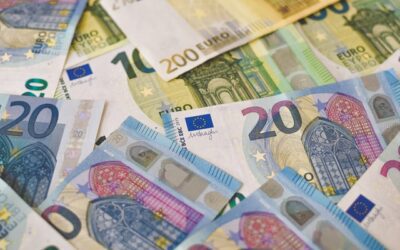Climate financing
We analyse EU funding initiatives driving climate innovation and industrial decarbonisation. Ensuring revenues from the EU ETS and CBAM are well spent.
ETS Revenues
The European carbon market, currently under review, will likely generate emission allowances worth over a trillion euros over 10 years, which is more than the EU’s entire Covid recovery budget. Under the current system, up to 43% of the emission cap can be distributed each year to industry to protect against carbon leakage.
The permits that are not given for free to industrial installations (and airlines) are sold or auctioned by the European Commission (via the EIB) or by Member States. A share of the proceeds is dedicated to the Modernisation Fund for poorer Member States to upgrade their energy infrastructure; another share is for the Innovation Fund.

Our Campaigns:
Accelerate the implementation of the CBAM and phasing out of free allocation
For the emission permits not given for free, make sure the proceeds are spent efficiently
The Innovation Fund
The EU’s Innovation Fund, launched in 2018, is the EU’s programme for funding cutting-edge low-carbon technologies. According to the European Commission, to be eligible, projects must be, highly innovative, cost-efficient, mature, scalable, and have a significant emission reduction potential.
The Innovation Fund is financed using revenues from the Emissions Trading Scheme (ETS), under which certain sectors must buy emission permits (allowances) to be allowed to pollute. We estimate that it will receive the proceeds from the sale of nearly 800 million emission permits over the period of 2021-2030. Subsidies come in the form of grants (paid mostly upfront) but may also include performance-based amounts in the future. In practice, the funding goes to sectors already receiving emission permits under the EU ETS.
We estimate that the fund will be worth €75 billion. How the money will be spent is therefore more critical than ever.
As Sandbag’s research showed, the Fund’s current granting approach is costly and inefficient. Upfront subsidies are used in the wrong way and do not address competitive distortions, leading to high decarbonisation costs instead of incentives for low carbon activities.
The scale of the climate change challenge requires careful funding allocation: more parsimonious subsidies to activities that do not expose investors to innovation-related risks would free up the funds needed to support activities with high abatement potential currently left out of the granting mechanisms.
The Parliament’s ETS revision proposal included the creation of a new Climate Investment Fund, which was closer to what Sandbag had suggested (a Carbon Neutrality Fund). Its scope would have been extended to “techniques, processes and technologies that may no longer be considered innovative” as was asked in the Parliament’s report in June 2022. This was later dropped during the ETS trilogues.
The Innovation Fund has been overhauled to reflect recent changes to the ETS. You can find Sandbag’s proposals submitted to the European Commission’s Innovation Fund Expert Group here.
Our Campaigns:
Avoid upfront funding to innovation as much as possible.
In our feedback to the European Commission’s Innovation Fund Expert Group, we detail how upfront funding crowds out private investment, does not incentivise performance and creates more risk of projects closing down (if their profits become negative). Instead, contracts (fixed premium or contract for difference) should be rewarded to projects on the basis of their performance.
Make resource-saving a requirement for Innovation Fund support.
The degree of resource saving is only covered by the IF criteria in optional ways. For example, as part of the “degree of innovation” criteria, the fact that a project also saves resources can be considered a “plus”. Resource-saving is key to scalability and should therefore be explicitly assessed in a mandatory criterion with equal importance as a project’s degree of innovation. Scalability should be considered on an economy-wide level.
Fix the funding gap for circularity
As incumbent technologies receive free emission allowances and innovative ones receive Innovation Fund money, the Innovation Fund makes circularity activities that are not innovative become even less competitive than they are already. Carbon contracts for substitution (not for difference) for these activities should be introduced to bridge this gap.
Read our analysis and policy recommendations
Innovation’s Black Friday
The EU’s Innovation Fund, launched in 2020, is one of the world’s largest programmes funding innovative low-carbon technologies. The fund can cover up to 60% of a project’s costs, mostly upfront with few strings attached. Earlier this month, the IF’s third large-scale...
RePowerEU financing plan shows how market makes decarbonisation harder
Read Sandbag’s feedback to RePowerEU on the European Commission’s website. We welcome immediate action to reduce Europe’s dependency on Russian fossil fuels in the face of its aggression against Ukraine. However, the European Commission’s proposal reflects the...
RePowerEU: Fiddling with the Carbon Market puts the Climate at Risk
[See new analysis with EC, EP and Council proposals] The European Commission’s plan to raise revenues from the Emissions Trading Scheme (ETS) increases the risk to exceed the market’s emission limit. On May 18th the European Commission announced a plan to use Europe’s...
EU ETS Revenues: Who Receives What? The Trillion Euro Question
This brief gives an analysis of the EU ETS Revenues, and aims to highlight, under various scenarios, how much is allocated to industry, Member States, and the Union’s budget respectively. The European carbon market, currently under review, will likely generate...
Feedback on the EU ETS reform
Sandbag welcomes the opportunity to provide feedback on the update of the EU ETS under the FF55 package. Our analyses [1] show that the proposed changes are not enough to guarantee that emissions will stay below the cap and that they could exceed it by 45% in 2030....
Harnessing EU Funds for Romania’s Energy Transition
Sandbag is pleased to launch our latest report on the energy transition in Romania. As a major regional actor and an important player in the European policy space, Romania has the potential to become a leader on climate action. However, political dynamics and a lack...

WHAT WE DO
TOOLS
PUBLICATIONS
NEWSLETTER
Mundo-b Matogné. Rue d’Edimbourg 26, Ixelles 1050 Belgium.
Sandbag is a not-for-profit (ASBL) organisation registered in Belgium under the number 0707.935.890.
EU transparency register no. 277895137794-73.
VAT: BE0707935890.





